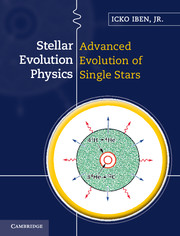Book contents
- Frontmatter
- Contents
- Preface
- Part IV Transport processes, weak interaction processes, and helium-burning reactions
- 12 Particle diffusion and gravitational settling
- 13 Heat conduction by electrons
- 14 Beta decay and electron capture in stars at high densities
- 15 Current–current weak interactions and the production of neutrino–antineutrino pairs
- 16 Helium-burning nuclear reactions and energy-generation rates
- Part V Evolution during helium-burning phases
- Part VI Terminal evolution of low and intermediate mass stars
- Index
- References
16 - Helium-burning nuclear reactions and energy-generation rates
from Part IV - Transport processes, weak interaction processes, and helium-burning reactions
Published online by Cambridge University Press: 05 December 2012
- Frontmatter
- Contents
- Preface
- Part IV Transport processes, weak interaction processes, and helium-burning reactions
- 12 Particle diffusion and gravitational settling
- 13 Heat conduction by electrons
- 14 Beta decay and electron capture in stars at high densities
- 15 Current–current weak interactions and the production of neutrino–antineutrino pairs
- 16 Helium-burning nuclear reactions and energy-generation rates
- Part V Evolution during helium-burning phases
- Part VI Terminal evolution of low and intermediate mass stars
- Index
- References
Summary
Because of the large Coulomb barrier between an alpha particle and another, heavier nucleus, temperatures at which helium-burning reactions occur in stars at interesting rates are considerably larger than temperatures at which hydrogen-burning reactions occur. Under appropriate conditions, a substantial fraction of interacting alpha particle, heavy nucleus pairs have relative kinetic energies such that the compound nucleus formed during a collision has an excitation energy close to the energy of a discrete level in the compound nucleus. For a reaction in which the compound nucleus decays with the emission of a gamma ray or a nucleon to form a stable nucleus, the cross section can become very large and the reaction is said to be a resonant one. In Section 16.1, the formation and decay of a compound nucleus is examined and the Breit–Wigner form for a single level resonant cross section is derived heuristically. In Section 16.2, the set of processes whereby three 4He nuclei combine to form 12C through resonant states of intermediate compound nuclei is examined. It is conventional to call the set of processes the triple-alpha process.
After the exhaustion of hydrogen over the inner 13% or so of its mass, a low mass star develops an electron-degenerate helium core and evolves upward in the HR diagram along a red giant branch burning hydrogen quiescently in a shell. The core grows in mass until, when it reaches a mass of about 0.5 M⊙, it has become sufficiently hot for the triple alpha process to terminate further core growth.
- Type
- Chapter
- Information
- Stellar Evolution Physics , pp. 1070 - 1100Publisher: Cambridge University PressPrint publication year: 2012



